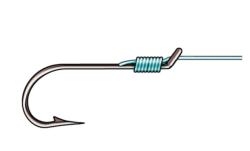Inside flipping and pitching
Pros reveal their lock-and-key flipping secrets
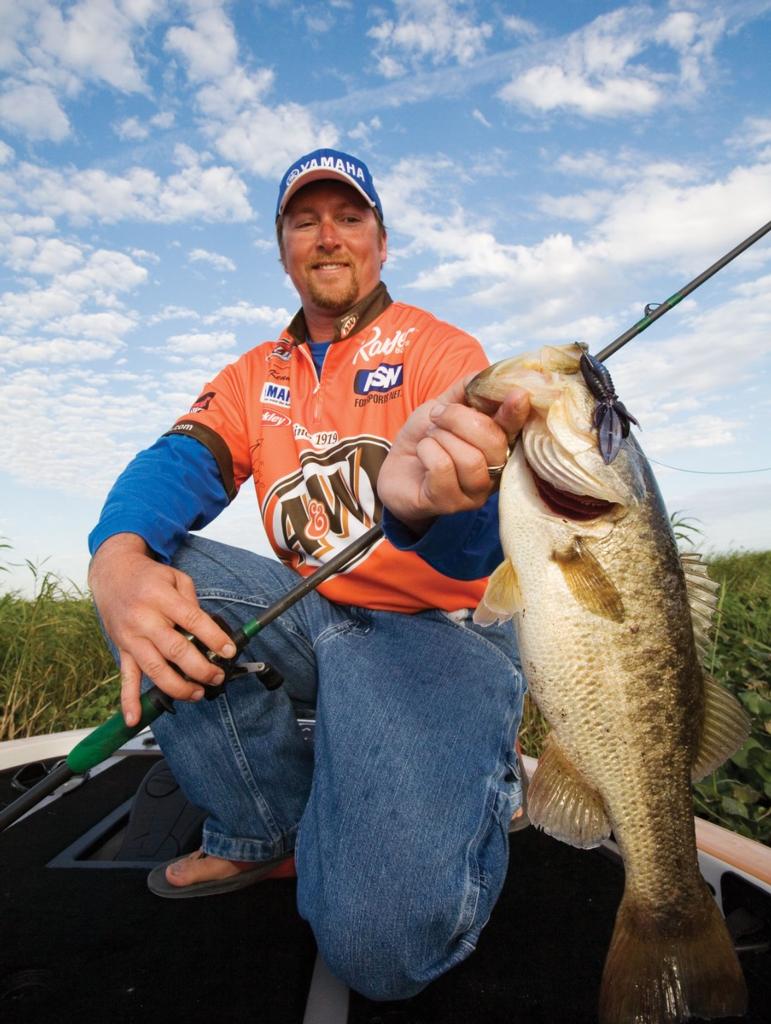
Having a hard time figuring out why you’re not catching bass up shallow when guys are winning tournaments left and right flipping bushes and grass? Chances are there is some little nuance these anglers have figured out in the rigging or preparation for their flipping and pitching that is giving them an edge.
Professional anglers are much like NASCAR crew chiefs in their craft. They are studying and tweaking the minutest of details that will give them a slight advantage over their competition and, more importantly, the fish.
But you don’t have to be a professional angler to employ a new trick or twist on your local waters that will lead to catching more and bigger bass.
There are endless ways to tweak your equipment and lures to get the most out of your presentations. We sampled some of the “big sticks” on the Wal-Mart FLW Tour for their “hush-hush” tweaks to flipping and pitching approaches.
J.T. Kenney’s heavy vegetation tweaks
J.T. Kenney of Frostburg, Md., has proven his prowess with a flipping stick on the mats and mazes of vegetation on Florida lakes like Okeechobee and Toho. But his success is as much about his preparation as it is about his tournament strategies.
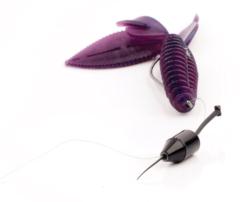 “The first thing I do is powder coat my tungsten weights,” Kenney said. “From there, I tie a snell knot to my straight-shank hook. Then I superglue my knot and use a rubber stopper to peg my sinker to my bait. I also thread a Sweet Beaver, or whatever bait I’m throwing, on the hook so I can pull the eyelet completely through the bait before pointing the hook back into the plastic. At the angle the line comes off the hook eye, it will actually act as a keeper, holding the bait in place.”
“The first thing I do is powder coat my tungsten weights,” Kenney said. “From there, I tie a snell knot to my straight-shank hook. Then I superglue my knot and use a rubber stopper to peg my sinker to my bait. I also thread a Sweet Beaver, or whatever bait I’m throwing, on the hook so I can pull the eyelet completely through the bait before pointing the hook back into the plastic. At the angle the line comes off the hook eye, it will actually act as a keeper, holding the bait in place.”
All of that sounds simple at first, but fully understanding the nuances of each element will help beginning anglers get more proficient with their approach. Kenney powder coats the weight to give it a slick finish, making his offering more streamlined for easier vegetation penetration. You can buy powder-coat paint for about $3.99 for a 2-ounce jar that will paint more than 100 jigheads or bullet weights.
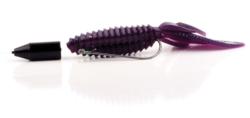
The key to successfully powder coating a weight is to heat it with a lighter or other heat source to a temperature hot enough to adhere the paint but not so hot that it scorches the paint when you dip it. It takes some practice and experimentation. The larger the weight, the longer it has to be heated. Using toothpicks or small nails to plug the ends will make life easier on you as well. Be sure to clear the holes before the powder paint dries.
Tying the snell knot is a little more difficult than your average Palomar knot, but the results can be outstanding when done properly. The adjacent illustration should help with the tying of the knot. The key is to keep each wrap on the hook shank snug and close to the last wrap. Then cinch the knot down by pulling the tag end through while holding the wraps in place. If done correctly, when you slide a slip-sinker down on the hook, you will see the hook point curl up like a scorpion tail. This action causes most bass to get hooked solid in the roof of the mouth.
The snell knot works effectively when you peg a bullet sinker as well, but precautions must be taken. The most important element is how tightly you snug the weight.
“If you peg the weight down so tight that it doesn’t slide up the line, the hook won’t kick, and you might as well just tie a Palomar knot on an offset hook,” Kenney said. It has to have room to move so when you set the hook, it slams against the weight and shoots the hook upward.
“Lots of guys are putting hitchhikers on their hooks to hold their plastic in place on a straight-shank hook,” Kenney said. “I do that when I’m practicing, but in a tournament I actually thread the hook all the way through the lure.”
Andre Moore’s heat shrink and homemade hooks
Who says all your fishing supplies have to come from the tackle shop? Pro Andre Moore buys a key component of his flipping equipment at the local electronics store. “I take a piece of small 8- or 10-gauge heat shrink that you use to insulate wires and melt it onto a straight-shank hook to act as a keeper,” he said.
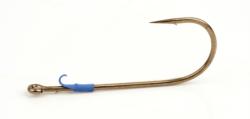 Moore cuts the heat shrink into a small 1/8-inch piece at a very sharp angle. He slides the heat shrink onto an untied hook so that the sharp end is pointing up toward the eyelet. Then he heats the heat shrink until it melts onto the shank. As it cools, he bends the pointed end away from the shank so that when it hardens, it acts as a soft-plastic keeper on the hook. He’s also careful to melt it onto the shank below the hook eye enough to leave room for the snell knot to be tied.
Moore cuts the heat shrink into a small 1/8-inch piece at a very sharp angle. He slides the heat shrink onto an untied hook so that the sharp end is pointing up toward the eyelet. Then he heats the heat shrink until it melts onto the shank. As it cools, he bends the pointed end away from the shank so that when it hardens, it acts as a soft-plastic keeper on the hook. He’s also careful to melt it onto the shank below the hook eye enough to leave room for the snell knot to be tied.
Many anglers have snapped off big bass in heavy vegetation on 65-pound braid, leaving them with that “gut-punch” feeling in their stomach. To their bewilderment they pull up their line to find it perfectly severed. Was it a sharp rock? No, it was the tiny gap that is found when manufacturers bend the hook shank to form the hook eye. While some anglers carry soldering irons to fuse hook eyes closed so braided line won’t slip into the crevice and sever on the hookset, Moore went to work on a permanent solution.
The result of his work is the BMF Hook that is coming to market from Reaction Innovations. The hook has a solid hook eye and wide gap along with two barbs on the inside of the shank. In a black-nickel finish, the hook alleviates all of the problems with open-gap hook eyes.
Matt Herren’s fluorocarbon line and jig hooks
“I’ve gone almost completely away from braided line since I’ve started flipping with fluorocarbon fishing line,” said pro Matt Herren of Trussville, Ala. “I get all the advantages of braid as far as strength plus the benefit of having a smooth, invisible line. I just don’t like braided line because of the sawing effect it has.”
Large-diameter fluorocarbon line withstands a ton of abuse with its abrasion-resistant coating. Because of the invisible properties of fluorocarbon, it’s easy to upsize your line without compromising stealthy properties of thinner monofilaments. The trick with fluorocarbon in large diameters is to condition the line to make it easy to cast and pitch. Sometimes the bigger line is hard to deal with, but using a line conditioner can alleviate some of the “memory” problems with large-diameter fluorocarbon.
“I’m also a firm believer in flat-eye jig hooks on all my jigs,” Herren said. “With a straight eye that is perpendicular to the hook shank, your knot can slide up or down on the eye and change the angle of your jig. Then, you go to set the hook, and the point is actually snapped down and away, and you’ll miss a fish completely.”
Andy Morgan’s brass wire and jig strands
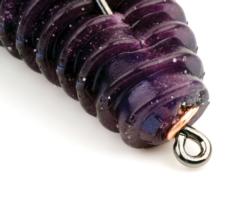 Another option for a plastic keeper on your hook is easily made in seconds with common brass or copper wire. Pro Andy Morgan of Dayton, Tenn., takes a small-diameter brass wire and wraps it around the shank a few times just below the eyelet and leaves the tag end sticking out. Then when the plastic bait is threaded onto the hook the wire holds it in place.
Another option for a plastic keeper on your hook is easily made in seconds with common brass or copper wire. Pro Andy Morgan of Dayton, Tenn., takes a small-diameter brass wire and wraps it around the shank a few times just below the eyelet and leaves the tag end sticking out. Then when the plastic bait is threaded onto the hook the wire holds it in place.
Morgan fishes jigs more than anything and has taken to tying custom skirts with meticulous precision. “I get real picky about how many strands my jig skirt has and how much of each color it has in it,” Morgan said. “Sometimes I might only have one little strand of orange in there for contrast. But the main thing I’m concerned with is altering the fall of the jig. A lot of times I just go up on line size to slow the fall of a small jig. But adding extra strands to the skirt can also slow a jig’s fall.”
He admits there are times he wants a fast fall on his jig, and he’ll tie a real thin, low-strand-count skirt. “When everyone is catching fish, how your jig falls really may not matter,” he said. “But in tournaments like the FLW Tour event on Pickwick this year, I was catching bass and lots of people were struggling. In those tough tournaments I think it does matter. And it gives me a lot of confidence with a tough bite.”
Jay Yelas’ braided line notes
“I flip braid a lot in dense cover,” said pro Jay Yelas of Tyler, Texas. “I don’t always peg my sinkers though. Sometimes I like the weight to be free, like when I fish a worm. Other times, like when I fish a tube, I want the weight pegged to the hook because the tube has a more tantalizing spiraling action when it’s pegged.
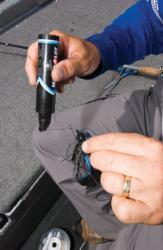 “A lot of people use fluorocarbon leaders tied with blood knots when flipping and pitching braided line,” Yelas said. “I just don’t trust that knot.”
“A lot of people use fluorocarbon leaders tied with blood knots when flipping and pitching braided line,” Yelas said. “I just don’t trust that knot.”
“Lots of guys will also opt for camouflaging braided line with a colored marker,” Yelas said. The marker can help mask the line and sometimes even marking the line in patches makes it more concealed in heavy cover.
“I will always tie a Palomar knot when I fish braid because a clinch knot will sometimes slip with it,” he said. “I still use a clinch knot or a Palomar knot with monofilament, but that’s mostly when I’m fishing in shallow water with sparse cover.”
Yelas has also employed new technology in his flipping and pitching. “Many guys who cast right handed will flip with left-handed reels so they never have to switch hands to reel. This is critical when you flip or pitch because often the bite comes as soon as the bait hits the water,” he said.
“With a Daiwa Viento reel, I can actually flip, engage the reel and even jig the bait all with one hand.” The Team Daiwa Viento reel comes with a “Twitchin’ Bar” that allows anglers to take up line by pressing a button.
“It’s perfect for flipping,” Yelas said. “You can take up as much or as little line as you want by how hard you press on the bar. If you just tap it, it will engage the spool, and if you press it hard it will turn the spool five or six times.”
———————————————————-
Snell knot
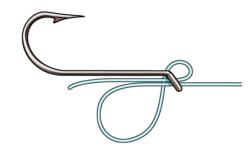
Insert one end of the leader through the hook’s eye, extending one to two inches past the eye. Insert the other end of the leader through the eye in the opposite direction pointed toward the barb of the hook. Hold the hook and leader ends between your thumb and forefinger and left hand. The leader will land below the hook in a large loop.
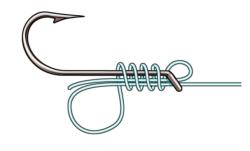
Take the part of the large lower loop that is closest to the eye and wrap it over the hook shank and both ends of the leader toward the hook’s barb.
Continue to wrap for seven or eight turns and hold the wrap in your left hand. Grip the end of the leader that is through the eyelet with your right hand and pull it slowly and steadily. Hold the turns with your left hand or the knot will unravel. When the knot is almost tight, slide it up against the eye of the hook. Grip the short end lying along the shank of the hook with a pair of pliers. Pull this end and the standing line at the same time to completely tighten the knot.
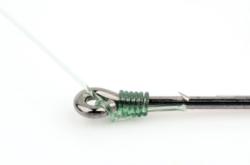
Many pros, including J.T. Kenney and Andre Moore, use a snell knot for flipping rigs. They claim it produces better hooksets.
